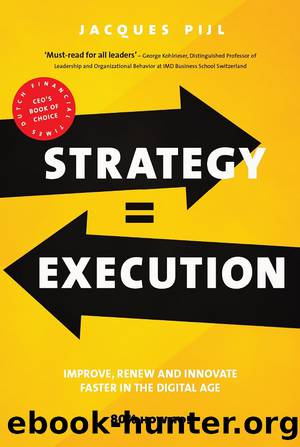Strategy = Execution by Pijl Jacques;

Author:Pijl, Jacques;
Language: eng
Format: epub
Publisher: Vakmedianet Management B.V.
6.1.2Set up a practical measuring system
Use a simple measuring system. Once youâve translated an initiativeâs maximum potential for improvement into a concrete execution target, you need a way to size up how well you are doing. Your analysis and design should be based on a quantitative foundation expressed in a number of substantial spreadsheets. For instance, a program aimed at cutting costs and improving back-office quality by means of effectiveness and efficiency targets definitely needs some strong independent analyses and benchmarks. Ultimately, those need to be condensed into a number of summaries that give a concise overview of the objectives, analyses, designs and business case at a glance. These summaries are often what you use to define a target for each process and, of course, to link this to the appropriate execution and benefit owners.
Measure! The key is to start measuring right away on the initiative you are executing. Effective leaders monitor the progress of the entire portfolio on a quarterly basis, and current initiatives every month. Better face the devil than fumble around blindfolded.
As we saw in Accelerator 2, you set goals at both strategic level and initiative level. If your goal is to realize 10% growth in a consolidating market, you will probably need to combine all three types of change initiatives. All leaders know how to forge growth targets by approaching them from several angles at the same time. Let me give three practical examples:
Sample Type 1 initiative: improvement project aimed at winning more contracts and thus increasing revenue from existing markets and customers. Type 1 Change (improvement) tends to focus on single goals and is executed in a single process within a single discipline. Its clarity of scope makes such an initiative easy to measure. In this example, a professional service organization implemented a Lean project to improve its tender conversion rate. Before the initiative, their conversion rate was one in seven. A process improvement team analyzed the situation and identified some quick wins and some minor and major improvements to be made in the sales process. The improvements had to do with optimizing the translation of customersâ request into deliverables; incorporating time for iterative consultation with the customer (instead of pretending that a single discussion is a good enough basis to make a tender); and explicitly formulating a vision on the customerâs request rather than simply copying the request.
By making these changes, the company improved its tender conversion to one in five in just three months, and one in four after six months. Without erring on the side of false precision, the process improvement team had made a baseline measurement and set up a clear-cut measuring system with three simple corrections built in: one for seasonal fluctuations; one for organic growth and what the day-to-day of Running the Business contributed to this; and one for employee turnover (the organization was growing and hiring new people). The team also introduced several objective measurement points. Once a month, the improvement projectâs contribution to the growth target was measured.
Download
This site does not store any files on its server. We only index and link to content provided by other sites. Please contact the content providers to delete copyright contents if any and email us, we'll remove relevant links or contents immediately.
Hit Refresh by Satya Nadella(8836)
The Compound Effect by Darren Hardy(8471)
Change Your Questions, Change Your Life by Marilee Adams(7343)
Nudge - Improving Decisions about Health, Wealth, and Happiness by Thaler Sunstein(7215)
The Black Swan by Nassim Nicholas Taleb(6737)
Deep Work by Cal Newport(6523)
Daring Greatly by Brene Brown(6208)
Rich Dad Poor Dad by Robert T. Kiyosaki(6156)
Principles: Life and Work by Ray Dalio(5917)
Man-made Catastrophes and Risk Information Concealment by Dmitry Chernov & Didier Sornette(5624)
Playing to Win_ How Strategy Really Works by A.G. Lafley & Roger L. Martin(5405)
Digital Minimalism by Cal Newport;(5353)
Big Magic: Creative Living Beyond Fear by Elizabeth Gilbert(5324)
The Myth of the Strong Leader by Archie Brown(5219)
The Slight Edge by Jeff Olson(5191)
Discipline Equals Freedom by Jocko Willink(5146)
The Motivation Myth by Jeff Haden(4979)
Stone's Rules by Roger Stone(4837)
The Laws of Human Nature by Robert Greene(4749)
